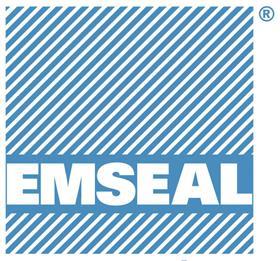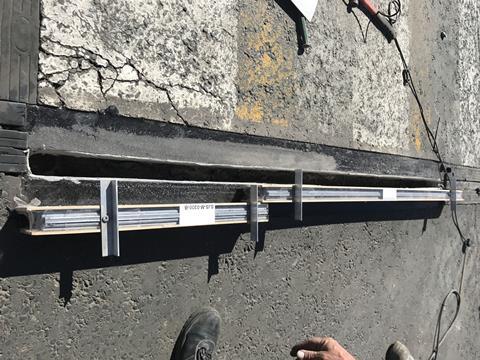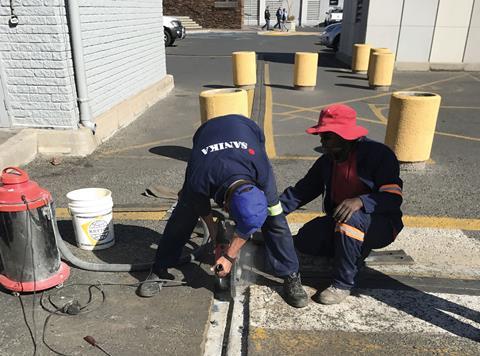Designing, detailing and installing the right kind of movement joints correctly is vital, as problems arising from joints create a hugely disproportionate amount of building repair, retrofit and refurbishment costs. This guide, sponsored by NCC-Emseal, outlines different types of joints, seals and technical issues facing the project team
CPD CREDITS: 60 MINUTES
DEADLINE: 15 JUNE 2018
For more information about Assemble Media Group’s CPD distance-learning programme, click here


INTRODUCTION
This CPD module will outline the types of joints involved in building and civil engineering structures and will look at technical issues facing contractors and maintenance personnel.
There are three basic types of joints:
- Construction joints – typically the daywork joints in concrete, where one pour or day’s work ends and another begins, which are normally bonded together with mechanical dowels and/or compounds and which have no future movement requirements. Additional joint sealing is not normally required.
- Connection joints, also known as isolation joints – these are usually at any interface between dissimilar materials or units, such as the gaps around window and door frames. They are normally filled with preformed or expanding foams, hidden by cover plates and sealed with simple trowelled or extruded elastic or flexible sealing compounds.
- Movement joints – typically a movement joint, also known as an expansion joint because its key function is to allow the building components on either side to expand, while the joint effectively shrinks, is a gap in a structure or structural element designed to separate its constituent parts and to accommodate movement of a defined nature and amount. The bigger and more complex the structure, the bigger and more complex the movement joints, and the bigger the challenges are in successfully accommodating the movement and simultaneously sealing them.

STANDARDS
Around the world there are multiple national and international standards relating to the dimensioning of movement joints in different building materials, including design standards that help to calculate the requirements and necessary locations for movement joints in and between different building materials. These still include BS 6093:1993/2006 Design of joints and jointing in building construction – Guide (+A1 update added 2013), together with the relevant Eurocodes. In North America this guidance is given in ASTM Guides, including C1193 and C1472, plus the older “Expansion Joints in Buildings, Technical Report No. 65 (1974)”, which is also still commonly referred to.

JOINT SEALANTS
Joint sealants for construction, isolation and smaller movement joints are sometimes referred to as “mastic” sealants, although there has never been a “mastic” sealant as such. Traditional mastic sealants in the UK and the US were predominantly linseed- or other plant oil- and bitumen-based flexible (although not elastic) sealers. Butyl rubber polymers and then the first acrylic joint sealants were produced in the mid-20th century. These were gradually replaced with more modern polymer technology and today are generally acrylic, silicone or polyurethane (PU) resin-based.
There are now many types of movement joint seals, from simple extruded joint sealants to preformed movement joints and other factory-produced, bespoke jointing systems, which are used according to the joint size, movement capability and other performance requirements as well as the structural design complexity.
Smaller movement joints are almost exclusively sealed with elastic extruded joint sealants (“mastic sealants”). These are designed for sealing low movement connection/isolation joints, and smaller, lower movement/expansion joints, generally less than 30mm in width and with a maximum joint movement capability of around 25%.
There are different standards for all the different extruded joint sealing materials used for the smaller and most commonly-occurring building and connection joints; predominantly this is now ISO 11600 “Building construction – joint-sealing products – Classification and requirements of sealants”.
However, there is still no unified standard or even consensus of approach in the UK, Europe, North America or elsewhere around the world on how to treat and seal larger movement/expansion joints, which is not entirely surprising due to the wide difference in movement and exposure demands that they can be required to accommodate.
MOVEMENT AND MOVEMENT JOINTS
Movement in buildings and civil engineering structures can be due to a number of factors including thermal effects from the environment and a structure’s simultaneous exposure to the controlled internal environment and external weathering, which can range from benign to the extreme in a short space of time, depending on location.
Additional factors that can cause significant movement in a structure or between different elements of a structure will obviously depend on its location, exposure and function. These can include static and dynamic loading, settlement and subsidence, wind sway, vibration from machinery or traffic, direct abrasion and impact from traffic, exposure to chemicals, and in some areas even seismic events.
While thermal movement can create joint movement in one direction or plane, there is also the potential for simultaneous movement in other directions and/or planes, which the joint movement system must accommodate. In some instances, in addition to the sideways movement created by normal thermal expansion and contraction of a concrete slab, there is also torsional/rotary movement, which can be created by the influence of other parts of the structure or from dynamic loading.
All these possible sources of movement need to be considered if the movement joints are to be successfully and durably sealed and made watertight.
In addition to movement, joint sealing requirements generally include one or more of the following demands: watertightness; fire resistance; thermal insulation; acoustic insulation; impact and abrasion resistance (eg footfall/vehicular traffic, plus wear and tear on the surface); UV light resistance; or chemical resistance. There could also be other project-specific requirements. For example, if a horizontal joint was being fitted into the top deck of a multistorey car park, the requirements might include traffic and abrasion resistance; frost, freeze and thaw resistance (including resistance to de-icing salts); and to be chemically resistant to oils and other automotive fluids. Fire resistance and thermal or acoustic insulation values might also need to be considered, depending on whatever occupies the floor levels immediately below or above the parking deck concerned.

AVOIDING COMMON JOINT PROBLEMS
The risk and the cost of claims against a property owner for liabilities brought about by failings in movement joints should not be underestimated. Avoiding the most common problems such as inadequate design, poor installation, or materials or systems with inadequate service-life or durability is essential.
A recent survey by the Sealant Waterproofing and Restoration Institute (SWRI) in North America found that projects – both new and refurbishment – experienced more problems with expansion (movement) joint seals than all other building product categories combined. One estimate suggested that up to 95% of building defects were related to movement joints, despite such joints representing around only 1% of the total original building cost. Rectifying these defects has been estimated as an additional overall building cost of between 5% and 10%.
The SWRI advises owners and specifiers to work more closely with joint manufacturers and installers in order to ensure movement joints are trouble-free. In part this might be achieved by project management teams designing, detailing, specifying, producing and installing movement joints in 3D using CAD. Such isometric joint layouts and details are particularly effective in showing and detailing all the required movement joints in the entire building.
In addition, for larger movement joints, wherever possible the transitions and connections should be specified and detailed as factory-made, with the movement joint suppliers also able to provide detailed 3D CAD drawings and detailed installation guidelines. This allows complex joint designs to be completed and fully assessed before they are manufactured and have to be installed. Problems can then be designed out, manufacturers can make systems that will be fit for purpose and contractors can more effectively install the end product.
Ideally, project management teams need to work from a defined and written movement joint checklist. This should include as much of the design detailing and performance information as possible and can then be circulated for input and comment by all project participants: the owners, architects, engineers and contractors, plus the joint system manufacturers to ensure that they can actually produce it. This will ensure all possible movement joint requirements are being considered and that they can be met through a clear definition and summary of the requirements. The Checklist approach is perhaps even more important for the refurbishment of existing structures to ensure that they are also made “watertight by design”.

LARGER MOVEMENT JOINT TYPES AND MATERIALS
Traditional wide movement joint sealing systems are primarily preformed and then assembled and installed on site. Types of large movement joint systems include: compressed joint seals, inflated joint seals, strip joint seals and foam seals, which comprise both closed-cell foam systems and alternative types of open-celled foam systems.
For the UK, these include the more recently introduced silicone-faced, pre-compressed, open-celled foam seals, which have been installed across North America for more than 25 years. Pre-compression significantly reduces work on site, not least in terms of the surface preparation, pre-treatment, drilling and any other mechanical fixing work required for installation. System durability and the need for future maintenance – and how this can be undertaken – are also important selection criteria for larger joint sealing solutions.
While these joint sealing products undergo varied testing and compliance regimes, as previously mentioned, there are no national or international standards required for them, largely because of the huge variation in the types of structures and specific functions required. However, prior to use in North America all such systems must be assessed, approved and monitored by the responsible federal, state and independent technical institutes, and from this work there is some increasingly clear guidance to assist owners and their professional teams in making the right system selection.

SUMMARY OF SEAL TYPES
The basic properties, advantages and disadvantages of these different types of large movement/expansion joint sealing technologies and systems can be summarised as follows:
- Compression seals – once the most commonly used solution for sealing larger, wider or higher movement capability joints, but today compression seals are increasingly being replaced by other solutions due to a tendency to be too rigid to satisfactorily seal substrate irregularities over a long period. They also tend to fail quickly when subjected to tension, requiring expensive replacement. In practical terms, compression seals cannot be regarded as watertight solutions and any such seals should undergo rigorous inspection during routine maintenance procedures and as part of all structural assessment surveys.
- Inflated seals (usually neoprene) – increasingly regarded as outdated technology since webbing rather than air is used to create back pressure, causing increasing stress on the adhesive/bond-line, resulting in premature failure when in tension. Inflatable seals also suffer from compression-set, which means permanent deformation with no elastic recovery, while the thermoset rubber material used to fabricate inflated seals cannot be welded. Consequently, all transitions must be glued and available adhesives for this purpose are not UV resistant, so cannot be used externally.
- Strip seals – also known as mechanically-fixed joint sealing profiles, these are often the best option for very wide vertical movement joints – certainly those in excess of 305mm – however they are not water or airtight. The biggest downside of this approach to surface sealing is that it can also create voids behind the sealing profile, leading to reduced fire resistance and reduced thermal insulation (R-value). Strip seals need intrusive mechanical anchoring and are not suitable for internal corners since there is no access for fixing them in position, consequently they are of limited use.
- Closed-cell foam seals – the most common type of closed-cell foam offered as a movement or expansion joint seal is ethylene vinyl acetate-based (EVA). In addition to EVA foams, closed-cell PU foam systems are sometimes used, although this material is more suitable for and commonly only used for joint fillers or backing rods under elastic waterproofing sealants and smaller movement joints of less 30mm wide. They are not ideal for use in larger or higher movement/expansion joints where elastic recovery is a key function for a durable watertight seal.
In EVA foams, the cells are filled with an inert gas, a “blowing agent”, usually carbon dioxide or a cyclopentane; any stress on the foam squeezes the cells, allowing the gas to escape permanently. This will accommodate the movement, but the foam will effectively shrink and permanent compression-set will begin. This reduces and then prevents any elastic recovery – as a result, the seals will eventually fail when in tension. Additionally, as these materials are not supplied pre-compressed for movement joint seals, they must be compressed on site so that they can be inserted into the joints and the compression-set limits or prevents any future elastic recovery.
According to established data, closed-cell foams quickly experience around 25% permanent compression-set under the normal movement and temperature cycles typically found in construction-related structural movement joint applications.
Open-celled foam seals – the most common type of open-cell foam offered as an expansion joint seal is PU resin-based. No gas is used as a blowing agent as the cells would not be able to trap the gas inside. Instead, a foam impregnation process is used. Some open-cell PU foam suppliers still use wax or bitumen impregnations, but these can also have very negative impacts on the physical properties of the foam when exposed to more extreme temperatures. For example, the wax or bitumen can melt and stain or damage adjacent surfaces, plus they will become rigid when exposed to low temperatures. Also, with these impregnations the PU foam cannot revert to its original shape and so this limits the foam’s ability to absorb movement.
An alternative solution was fortunately found for open-celled PU foam seals, using acrylic polymer impregnations. These are also water-repellent and have no negative impact on the physical properties of the foam material, including at higher or lower temperatures, making it ideal for use in larger, wider and higher movement capability requirement expansion jointing systems. Another important advantage is that products produced with this material can be factory pre-compressed so that they can be easily inserted and bonded, not mechanically fixed, into the joints on site. These are huge advantages that should not be underestimated.
Open-celled foam seals (silicone faced) – these are the newest form of this technology now introduced to the UK, which uses the acrylic resin-impregnated PU foam specifically developed for larger preformed movement joints, already used in North America. These silicone faced foam seals provide watertight joints and do not require invasive anchor fittings.
Once on site and immediately prior to installation, the product’s protective packaging is removed and the pre-compressed system is inserted into the joint onto freshly applied adhesive, where it slowly expands to fill and seal the joint, including any voids and surface irregularities on the arrises (joint sides). These materials can therefore also have high R values and a high sound transmission coefficient to provide excellent thermal and acoustic insulation on facades, as well as between floors.
RECENT INNOVATIONS
There have also been many other recent innovations in accommodating the requirements of wider and higher movement joint sealing performance with open-celled foam seals, including systems with recent certification of up to a four-hour fire rating in accordance with EN1366-4, the highest test classification possible (identical to BS 476). In North America, these systems are also tested for fire resistance in accordance with UL 2079 and again achieve the highest test classifications.

How to take this module
Assemble Media Group’s CPD distance-learning programme is open to anyone seeking to develop their knowledge and skills. Each module also offers members of professional institutions an opportunity to earn between 30 and 90 minutes of credits towards their annual CPD requirement.
This article is accredited by the CPD Certification Service. To earn CPD credits, read the article and then click the link below to complete your details and answer the questions. You will receive your results instantly, and if all the questions are correctly answered, you will be able to download your CPD certificate straight away.
CPD CREDITS: 60 MINUTES
DEADLINE: 15 JUNE 2018
Privacy policy
Information you supply to Assemble Media Group Limited may be used for publication and also to provide you with information about our products or services in the form of direct marketing by email, telephone, fax or post. Information may also be made available to third parties. Assemble Media Group Limited may send updates about Building CPD and other relevant Assemble Media Group Limited products and services. By providing your email address you consent to being contacted by email by Assemble Media Group Limited or other third parties. If at any time you no longer wish to receive anything from Assemble Media Group Limited or to have your data made available to third parties, contact the Data Protection Coordinator at building@building.co.uk. View our full privacy policy at www.building.co.uk/cpd





























1 Readers' comment